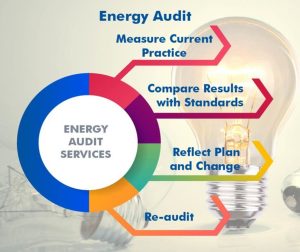Energy Audit
Although energy audits are readily available to most people, few folks choose to get one. The likely reason is that most are unaware they exist or how beneficial they can be.
An energy audit can help reduce your carbon footprint by pinpointing trouble areas in your home or commercial building that may be wasting energy. And as you know, reducing your energy consumption can help save money on your energy bill.
This guide will further explain what an energy audit is, why it can reduce energy costs, and how it can evaluate your building’s impact on the environment.
What Is an Energy Audit?
An energy audit is completed at a residential or commercial building to determine its energy efficiency. Simply put, energy efficiency means using less energy to do the same job. The audit will provide you with a complete electricity consumption and energy efficiency assessment.
You can obtain important information regarding your energy usage and Energy Star rating from the audit report. With this information, you can identify and correct any energy usage issues to cut electricity costs. It’s advisable to always undertake an energy audit before implementing a renewable energy system.

Who Conducts an Energy Audit?
A registered energy advisor or energy auditor will conduct a home energy audit or business energy audit. In addition, energy auditors are responsible for completing energy efficiency assessments of commercial and non-commercial buildings.
What Is Done During an Energy Audit?
There are three parts to an energy audit: evaluation, testing, and efficiency recommendations.
Once the audit is complete, the auditor will provide you with a report outlining energy consumption, a final energy grading, and home improvement suggestions to cut energy costs on energy bills.
The Evaluation
A registered energy auditor will come to your home or business and conduct a walk-through of the inside and outside to determine your energy usage and problem areas.
While conducting their walk-through, they will analyze specific elements that contribute to your home’s or business’s overall energy efficiency.
The auditor will analyze the heating and cooling systems, or HVAC system, and your insulation levels, including the basement and exterior attic walls. In addition, they will measure and count how many doors and windows the building has and take external measurements.
Air tightness And Other Tests
The second part of an energy audit involves an air tightness test, also known as a blower door test. During this test, an energy auditor will determine how tight a building’s envelope is by checking for air leakage in a house or business. During an airtightness test, an air sealing procedure is done. The auditor will seal the front door of the building, and they will place a large fan inside.
The testing fan will pull the interior air outside the building, which will force outside air to come through any cracks or holes. Often, these air leaks are easily felt with your hand, but most auditors will use feathers or incense to accurately determine where the cracks are located.
In addition to the airtightness test, an energy auditor will assess your business or home’s energy use by conducting a thermographic scan. Moreover, they will use various energy usage equipment items to measure energy consumption, such as infrared cameras, surface thermometers, and furnace efficiency meters.
Recommendations to Improve Energy Efficiency
Once your residential or commercial building has been evaluated and testing has been completed, the energy auditor will provide you with a thorough list of recommendations regarding energy efficiency improvements you can undertake. If implemented, most of the recommendations will help you save money on utility bills.
Are There Different Types of Energy Audits?
Two types of energy audits are available: a preliminary energy audit and a detailed energy audit. The type you choose will depend on your needs.
Preliminary energy audit: This type of audit is simply a data-gathering exercise that offers a preliminary analysis. Often the auditor will conduct this type of audit via a walk-through investigation. A professional energy auditor will utilize readily available data and limited diagnostic instruments to complete a preliminary energy audit.
Detailed energy audit: This type of audit is completed by a professional auditor who monitors, analyzes, and verifies energy use to establish problem areas and ways to implement energy efficiency improvements. They will present their findings and suggestions in a detailed technical report. Additionally, during a thorough energy audit, a professional energy auditor will use sophisticated instrumentation such as a flue gas analyzer, a scanner, and a flow meter.
